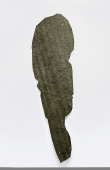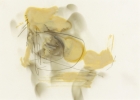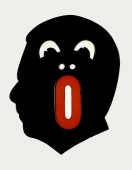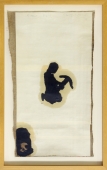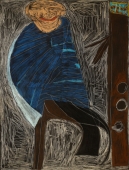
Artist | Markus Raetz (1941 - 2020)
Alias: Markus Raetz [Markus Rätz]
https://www.artist-info.com/artist/Markus-Raetz
Biography
Biography
born in 1941
About the work (english / deutsch)
About the work (english / deutsch)
In General
Markus Raetz seems to have created an oeuvre composed of ideas, almost as if each new day had brought a new idea with it. But this is deceiving. I know no other work that is the product of a lengthier process. Certainly, he does not just spin one thread, but rather many, and the path of research that he treads is predefined. Yet that is the way things are with research: Along the path one encounters a wide variety of different events in the form of insights, sudden compositions and new objektives these do not render the original point of departure obsolete, but rather take it up and incorporate it. Markus Raetzs research or researches focus on an issue on which the notion of process itself essentially rests, namely perception, by which I mean a conscious contemplative viewing. Given that Markus Raetz researches perception, the elements which jell to make what is perceived a work are geare toward this conscious act of viewing it.
To paraphrase the usual saying: The sum of the parts by no means automatically creates a whole. And Markus Raetz sometimes quite literally entices a sum out of the parts, indeed wrests it from them in almost innumerable different steps (and he always remains playful, never merely doggedly determined). It is a sum which leads to perception dissolving in the perceived and conversely to the perceived taking the form of perception. This may sound tautologous, indeed it is to a certain degree, but it turns out precisely for that reason to be a "good idea“.
The part, the whole and perception (the perceived) are, however, kept at a distance from each other by movement: by means of the movement of the perceiver.
I look at a picture frontally und it sets my imagination in motion. And things are not fundamentally different when viewing a sculpture: each static view is the product of a viewpoint somewhere in a circumference of 360º. The movement expressed by the sculpture - e.g. the rotation of the human body - creates the memory (as an image) in the mnemonic sphere defined by the sculpture. (Whoever has seen Le Corbusier’s Ronchamp or Frank Gehry’s chair museum in Weil am Rhein knows how annoying it is if the respective different partial views cannot be fused in your memory to create an overall picture or image.) Memory does not create a picture of the whole. The picture remains forever partial.
This is just as much true of the partial image of the sequence of movements in a kinetic sculpture, such as those built by Jean Tinguely, or Richard Serra’s large sculptures, which can only be viewed by walking around them. Given that memory is a subjective experience of the human capacity to remember, each of us carries our own mind’s pictures of the sculptures home with us.
In Markus Raetz’ work, the self-reflecting act of perception is constituted on the basis of the movement.
If, in other words, perception is always essentially a matter of a process, then Markus Raetz illustrates this by incorporating the movement of the perceiver into this process in such a manner that the perceiver becomes aware of his or her own movement. Or, put differently, I, in myself and with myself, embody the exploring slow motion by means of which I recognize something within my own mnemonic space: as a memory of myself. This is why Markus Raetz’ so-called "good ideas" are by no means sensational. For they are geared towards recognition itself (what I do not recognize I, quite simply, do not see). Yet this form of recognition is ecstatic in the sense that I am able to perceive this recognition as a process: namely, as an image that generates itself only then to dissolve. The process is deeply ironic, for I am seeing myself In a uncommonly poetic way Markus Raetz succeeds in astonishing us and yet making us chuckle. In this regard he is certainly playfully impish. In a nutshell: process, picture, movement, perception. We concern ourselves with these „things“ day-in, day-out, consciously and subconsciously. The multiplicity of materials which Markus Raetz unifies in his work by seeking and finding them is both coincidental and exemplary. The materials are parts, are the means which do not serve an end but rather, owing to their specificity generate this or that image.
In Markus Raetzs work we encounter something like a philosophy of the material, right down to the individual brushstrokes, which are executed such as to contain for example, both light and shadow simultaneously, thus functioning both two-dimensionally and three-dimensionally. The many different materials are not just a way of lending expression to something but are also constitutive in bringing to light the quintessence of perception and the perceived and the order assigned to them. This being the case, the question arises: What was there first, the chicken or the egg? Precisely this question - the question of creation itself - also emerges as another theme in Markus Raetz’s work, as one of the consequences of his playful researching method.
German text by Jean-Christophe Ammann / Translation by Jeremy Gaines
(Extract - Full printed version available in the Museum)
MMK - Museum für Moderne Kunst, Frankfurt am Main
Allgemeines
Das Schaffen von Markus Raetz scheint aus Einfällen zu bestehen. Gewissermaßen: jeden Tag eine neue Idee. Der Schein trügt! Ich kenne keine Arbeit des Künstlers, die nicht das Produkt eines langandauernden Prozesses wäre. Sicher, er spinnt nicht einen einzigen Faden. Es sind deren viele, und der Weg der Forschung, den er beschreitet, ist vorgegeben. Aber wie es eben so ist in der Forschung: Auf diesem Weg gibt es Ereignisse ganz verschiedener Art in Form von Erkenntnissen, plötzlichen Konstellationen, neuen Zielvorgaben, welche die ursprünglichen zwar keineswegs überflüssig machen, sie jedoch einbinden und umwandeln. Die Forschung oder Forschungen von Markus Raetz beinhalten ein Thema, dem das Prozeßhafte vom Wesen her zugrunde liegt, nämlich die Wahrnehmung. Gemeint ist ein bewußtes, kontemplatives Schauen. Da Markus Raetz die Wahrnehmung als Thema erforscht, sind die Teile, die das Wahrgenommene als Werk konstituieren, auf dieses bewußte Schauen hin ausgerichtet.
Wie man so schön sagt, ergibt eine Addition der Teile noch kein Ganzes. Die Summe, die Markus Raetz diesen Teilen manchmal buchstäblich entlockt, manchmal in schier unzähligen Schritten abringt - nie verbissen, sondern immer spielerisch - führt dahin, daß die Wahrnehmung im Wahrgenommenen aufgeht und umgekehrt das Wahrgenommene die Form der Wahrnehmung einnimmt. Das klingt tautologisch, ist es auch bis zu einem gewissen Grad, und offenbart sich gerade deshalb als „guter Einfall“.
Der Teil, das Ganze und die Wahrnehmung (das Wahrgenommene) werden allerdings durch die Bewegung voneinander distanziert: mittels der Bewegung des Wahrnehmenden.
Ein Bild schaue ich mir frontal an, und es bewegt meine Einbildungskraft. Eine Skulptur schaue ich mir nicht grundsätzlich anders an: Die statischen Ansichten ergeben sich aus Blickpunkten im Umkreis von 360’. Die in der Skulptur ausgedrückte Bewegung - z. B. eine Rotation von Menschenleibern - schafft die Erinnerung (als Bild) in dem durch die Skulptur geprägten Gedächtnisraum. (Wer einmal Ronchamp von Le Corbusier oder das Stuhlmuseum von Frank Gehry in Weil am Rhein besucht hat, weiß, wie ärgerlich es ist, wenn sich die jeweils verschiedenen Teilansichten über die Erinnerung nicht zu einem Gesamtbild kurzschließen lassen.) Die Erinnerung schafft das Bild des Ganzen nicht. Das Bild bleibt immer partiell.
Das trifft ebenso zu für das partielle Bild eines Bewegungsablaufes in einer kinetischen Skulptur, zum Beispiel bei Jean Tinguely, oder einer weiträumig abzuschreitenden Skulptur von Richard Serra. Da die Erinnerung eine subjektive Erfahrung des Gedächtnisses ist, trägt jeder die eigenen Bilder nach Hause.
Bei Markus Raetz konstituiert sich aus der Bewegung heraus der sich selbst reflektierende Akt der Wahrnehmung.
Wenn also Wahrnehmung grundsätzlich prozeßhafter Natur ist, so verdeutlicht dies Markus Raetz dadurch, daß er die Bewegung des Wahrnehmenden mit in diesen Prozeß einbezieht, und zwar so, daß sich der Wahrnehmende seiner Bewegung bewußt wird, was in etwa heißt: Ich verkörpere die tastende „Zeitlupe“ in und mit mir selbst, mit der ich etwas erkenntnishaft in meinem eigenen Gedächtnisraum wiederfinde: als Erinnerung meiner selbst. Deshalb sind die sogenannten „guten Einfälle“ von Markus Raetz keineswegs sensationell. Denn sie sind auf das Erkennen angelegt (was ich nicht erkenne, sehe ich nicht). Dieses Erkennen aber ist ein ekstatisches, weil es so angelegt ist, daß ich dieses Erkennen als Vorgang wahrnehme: als ein sich schaffendes und wieder auflösendes Bild. Der Vorgang ist zutiefst ironisch, denn ich schaue mir ja selbst zu. Auf eine ungewöhnlich poetische Art und Weise gelingt es Markus Raetz, den Betrachter, zum Staunen und zum Schmunzeln zu bringen. Der Schalk ist sein spielerischer Weggefährte. Der langen Rede kurzer Sinn: Prozeß, Bild, Bewegung, Wahrnehmung. Mit diesen "Dingen“ beschäftigen wir uns tagtäglich bewußt und unbewußt. Die Vielzahl der Materialien, die Markus Raetz über das Suchen und Finden in seinem Werk vereint, ist beiläufig und exemplarisch. Die Materialien, das sind die Teile, die Mittel, die nicht zweckgerichtet, sondern aufgrund ihrer Eigenart dieses oder jenes Bild schaffen.
Es gibt bei Markus Raetz so etwas wie eine Philosophie des Materials bis hin zum Pinselstrich, der so ausgeführt wird, daß er beispielsweise Licht und Schatten zugleich beinhaltet, somit Fläche und Raum bewirkt. Die vielen verschiedenen Materialien sind nicht einfach Ausdrucksträger, sondern sie generieren konstitutiv Wahrnehmung und Wahrgenommenes in der ihnen zugrunde liegenden Natur und in dem ihnen zugeordneten Dispositiv.
Wenn dem so ist, stellt sich bald die Frage: Was war zuerst da, das Ei oder das Huhn? Genau diese Frage - die Frage nach dem Schöpferischen schlechthin - wird als ein weiteres Thema im Schaffen von Markus Raetz offensichtlich, als eine Konsequenz seiner spielerisch-forschenden Methode.
Text von Jean-Christophe Ammann
(Auszug - Der vollständige Text ist als Informationsblatt beim Museum erhältlich)
MMK - Museum für Moderne Kunst, Frankfurt am Main
Bibliography
Bibliography
Markus Raetz, Zeichnungen, Bern Art Museum 1977
Markus Raetz, Arbeiten/Travaux/Works 1971-1981; Kunsthalle Basel, etc., Basel, 1982
Markus Raetz, Arbeiten 1962 bis 1986; Kunsthaus Zürich etc., Zurich, 1986
Bernhard Bürgi: Markus Raetz. Die Bücher. 1972/1976, 2 vols, Stähli, Zurich, 1987
Markus Raetz - les estampes/die druckgraphik/the prints. 1957-1991, Cabinet des Estampes, Musée d’art et d’histoire, Geneva, Bern, Zurich, 1991.
 offers / Requests offers / Requests  |
About this service |
|---|
 Exhibition Announcements Exhibition Announcements  |
About this service |
|---|
 Visualization |
Learn more about this service | ||
|---|---|---|---|

Interested in discovering more of this artist's networks?
3 easy steps: Register, buy a package for a visualization, select the artist.
See examples how visualization looks like for an artist, a curator, or an exhibition place: Gallery, museum, non-profit place, or collector.

Exhibition History

|
SUMMARY based on artist-info records. More details and Visualizing Art Networks on demand. Venue types: Gallery / Museum / Non-Profit / Collector |
||||||||||||
| Exhibitions in artist-info | 99 (S 42/ G 57) |
Did show together with - Top 5 of 1636 artists (no. of shows) - all shows - Top 100
|
||||||||||
| Exhibitions by type | 99: 17 / 37 / 42 / 3 | |||||||||||
| Venues by type | 66: 14 / 22 / 27 / 3 | |||||||||||
| Curators | 30 | |||||||||||
| artist-info records | Apr 1964 - Nov 2017 | |||||||||||
|
Countries - Top 5 of 8 Switzerland (42) Germany (23) France (9) United States (9) Italy (4) |
Cities - Top 5 of 36 Bern (12) Zürich (11) Frankfurt am Main (9) New York (7) Basel (6) |
Venues (no. of shows )
Top 5 of 66
|
||||||||||
Curators (no. of shows)
Top 5 of 30
|
| Daimler Contemporary Berlin | G | Jun 2017 - Nov 2017 | Berlin | (14) | +0 | |
| Wiehager, Renate (Curator) | +0 | |||||
| Deutsche Bank Collection - Artists | S | Apr 2015 - Apr 2015 | Frankfurt am Main | (1) | +0 | |
| Migros Museum für Gegenwartskunst - Zürich | G | Aug 2014 - Nov 2014 | Zürich | (121) | +0 | |
| Welter, Judith (Curator) | +0 | |||||
| Musée Jenisch Vevey | S | Jun 2014 - Oct 2014 | Vevey | (12) | +0 | |
| Aargauer Kunsthaus | G | May 2014 - Jul 2014 | Aarau | (103) | +2 | |
| Kunstmuseum Bern | S | Jan 2014 - Apr 2014 | Bern | (107) | +1 | |
| Keep reading |















